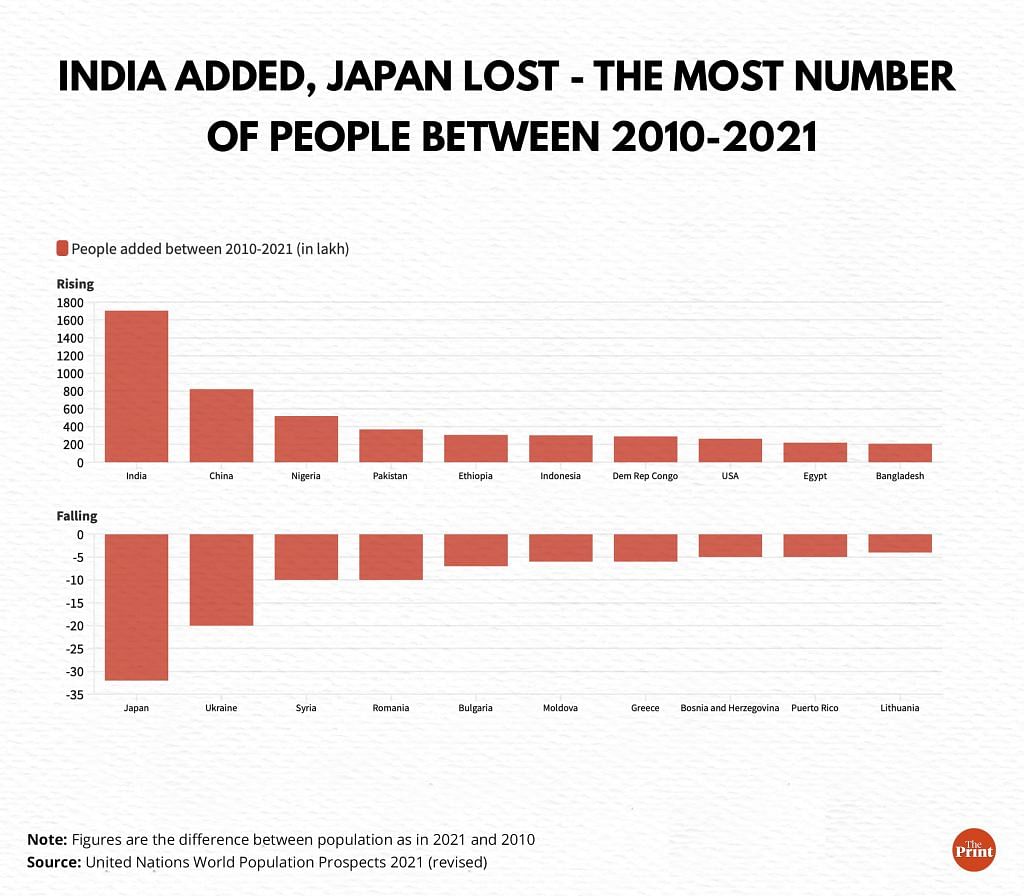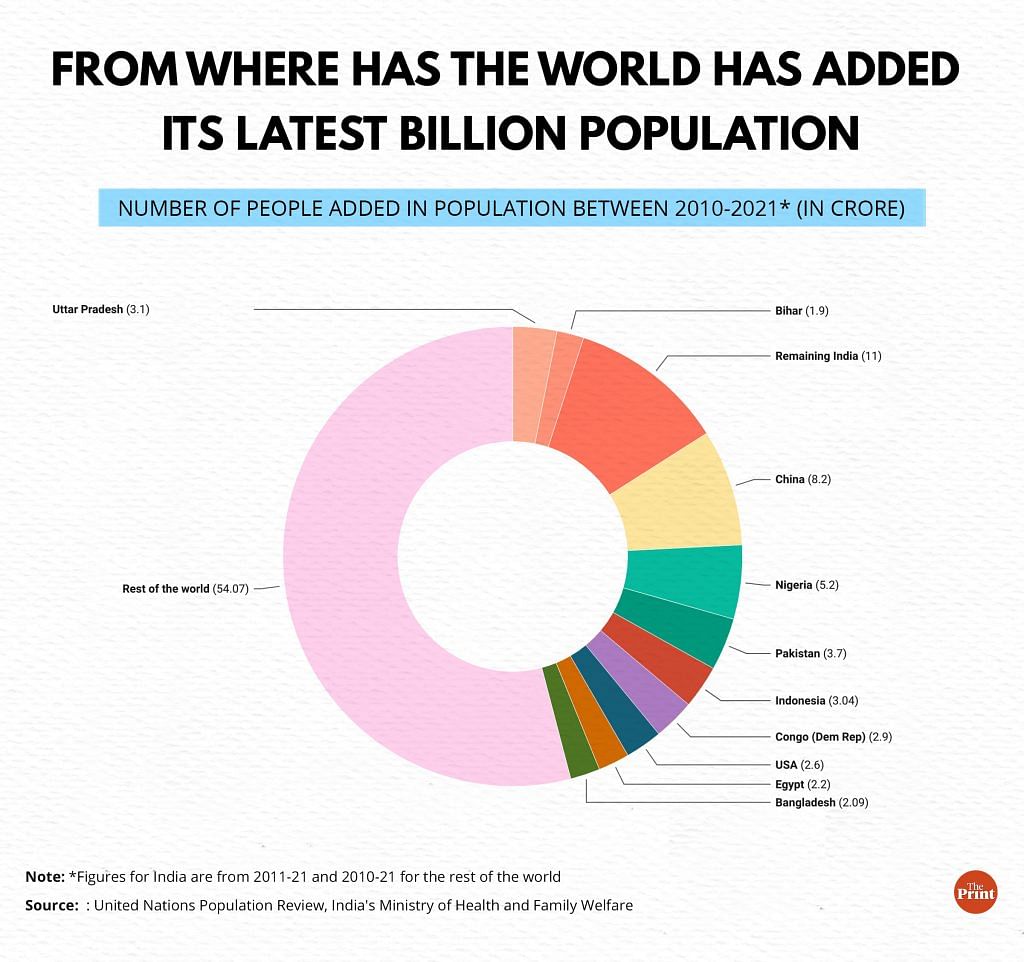New Delhi: The world’s population went up by 1 billion in the last 12 years to reach the milestone of 8 billion on Tuesday with India contributing the highest in this period, according to the United Nations’ Population Fund (UNPF).
A detailed look at the UN numbers reveal that India added a little over 170 million (17 crore) people to its population between 2010-2021 — which is about 17 per cent of the 1 billion people the world has added. India is expected to surpass China to become the world’s most populous country by the next year.
Data also shows that most of India’s contribution has come from two states — Uttar Pradesh and Bihar — which account for approximately 5 per cent of the world’s latest billion addition.
Other countries are miles behind India in terms of population addition with China coming second (8 crore), followed by Nigeria (5.2 crore), Pakistan (3.7 crore) and Ethiopia (3.08 crore).
Also Read: Karnataka’s sex ratio at birth plummeting, govt data shows. Not so straightforward, say experts
Uttar Pradesh and Bihar’s contribution
Nestled in the Gangetic plains, Uttar Pradesh and Bihar are among the most populous states in the country. Collectively, these two states are home to about 35.4 crore people, which is more than the population of the US, the third-most populous country in the world.
Though the UNPF doesn’t provide state-wise data, the Government of India’s population projections for 2021 make the comparison possible, albeit with an omission of one year (2010).
According to the population projections released by the Ministry of Health and Family Welfare in 2020, India has added a little more than 15 crore people (150 million) between 2011-2021, or 1.5 crore each year on average.
Uttar Pradesh’s population is estimated to have grown from 19.98 crore in 2011 to 23.09 crore in 2021 and Bihar’s has grown from 10.4 crore to 12.3 crore. Clubbed together, the two states have added more than 5 crore people in the past decade, which is about 5 per cent of the 1 billion (100 crore) people the world added in around the same time.
Besides these two states, Maharashtra has added 1.21 crore people, Madhya Pradesh 1.19 crore and Rajasthan 1.07 crore, about 3 per cent of the world’s newest 100 crore club.
The five southern states — Karnataka, Tamil Nadu, Kerala, Andhra Pradesh and Telangana — and the Union Territory of Puducherry have collectively gained only 2.38 crore people, not even 3 per cent of the world’s newest billion.
This population rise also has to do with the fertility rates prevailing in these states. The Total Fertility Rate (TFR), which measures the average number of children a woman is likely to give birth to in her reproductive years, is projected to be less than 2 children per woman for India on average, according to the Health Ministry’s projections based on the Census.
The TFR is more than two children in Bihar (2.92), Uttar Pradesh (2.3), Madhya Pradesh (2.3), Rajasthan (2.2) and lower in southern Indian states —1.54 each in Tamil Nadu, Telangana and Andhra Pradesh, 1.64 in Karnataka and 1.79 in Kerala.
Rising poor, falling rich
The UN data also shows that a majority of the world’s newest population is coming from “least developed countries”, where people do not even earn $1,018 (Rs 82,416.17) average income in a year and are vulnerable to economic and environmental shocks.
These countries have added about 89 crore people between 2010-2021. Contrast to this, the high-income countries — where a person earns more than $12,615 (Rs 10.22 lakh) per year on average — have added only 6.73 crore over the same time.
This is visible in the countries where more people lived in 2010 than they did in 2021.
 Japan’s population has come down by 32 lakh, Ukraine’s population by 20 lakh, Syria and Romania by 10 lakh. It has come down by more than 5 lakh in Bulgaria, Moldova, Greece, Bosnia and Herzegovina and Puerto Rico.
Japan’s population has come down by 32 lakh, Ukraine’s population by 20 lakh, Syria and Romania by 10 lakh. It has come down by more than 5 lakh in Bulgaria, Moldova, Greece, Bosnia and Herzegovina and Puerto Rico.
The population in wealthier countries is declining due to aging. According to an International Monetary Fund (IMF) report, in the coming 40 years (beginning 2020), Japan’s population loss will be almost equal to the present day population of Malaysia.
(Edited by Geethalakshmi Ramanathan)
Also Read: India to lose ‘demographic dividend’? Govt report says over-30s to outnumber ‘young’ by 2036




